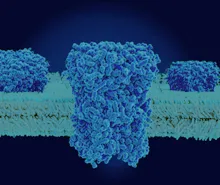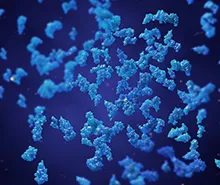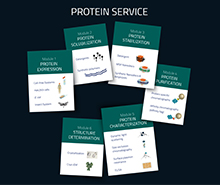Protein Services
As a CRO team of passionate (membrane) protein scientists, we offer small to mid-scale, protein services for a broad range of applications.
From custom protein expression services to characterization and cryo-EM protein structure determination, everything is possible.
From custom protein expression services to characterization and cryo-EM protein structure determination, everything is possible.
Individual work packages made up of our modular structure can be tailored to your specific needs.
Custom Functionalized Particles Solutions
We deliver custom particle functionalization solutions that precisely match your specifications, addressing unique functionality requirements for targeted applications.
Our service encompasses the whole process from material selection to functionalization and from proof-of-concept to industrial-scale production of bespoke (nano)particle constructs.
Our service encompasses the whole process from material selection to functionalization and from proof-of-concept to industrial-scale production of bespoke (nano)particle constructs.
.png)
We can guarantee the functionalization of your choice with a defined number of biomolecules and in the case of nanoparticles, we can even offer single-molecule functionalization.
Our service spectrum encompasses particle functionalization with:
Our service spectrum encompasses particle functionalization with:
- Small molecules
- Proteins
- Protein-specific antibodies
- Nucleic acids

Modules of our Protein Service

Module 1
Protein Expression
SYSTEM 1

CELL-FREE EXPRESSION SYSTEM
Advantages: Direct stabilization and co-translational integration of membrane proteins into nanodiscs; useful for toxic proteins
Amount of purified protein: Highest among our expression systems
Amount of purified protein: Highest among our expression systems
SYSTEM 2

BACULOVIRUS INSECT SYSTEM
Advantages: Near mammalian-like post-translational modifications; Easy to handle eucaryotic expression system
Amount of purified protein: Higher than mammalian cell lines
Amount of purified protein: Higher than mammalian cell lines
SYSTEM 3

HEK293 CELLS
Advantages: Homolog mammalian protein expression
Amount of purified protein: Lowest of the three, but with the highest authenticity among our systems
Amount of purified protein: Lowest of the three, but with the highest authenticity among our systems
We typically start with sequence-optimized, full-length genes expressing the wild type protein. In accordance with the project's requirements, different constructs with different affinity tags and positions can be included.
We are optimizing the protein expression to the fullest. Next to the expression systems, features that we optimize for maximum protein yield are:
- Expression conditions (media, temperature, induction conditions)
- Promoter regions (strong/weak expression, tightness of control)
- Type and position of the affinity purification tag
- Optional: best-expressing domains, including a boundary screen of domain borders

Module 2
Protein Solubilization
This step is essential to obtain structural intact and functional membrane proteins. Our membrane protein service contains two different methods for this step that you can choose from:
Ultrapure Detergents: Detergents are the classic approach to solubilize membrane proteins. Using them requires a screening process to identify the detergents that fit your membrane protein best. Of course, Cube Biotech will perform this screening process. Detergent screening parameters are:
Ultrapure Detergents: Detergents are the classic approach to solubilize membrane proteins. Using them requires a screening process to identify the detergents that fit your membrane protein best. Of course, Cube Biotech will perform this screening process. Detergent screening parameters are:
- Detergent Concentration
- Solubilization time
- Buffer composition
Module 3
Protein Stabilization
This module is the next step after protein solubilization. Its goal is to stabilize membrane proteins and keep them functional after their native cell membrane has been removed. The main idea is to mimic the original cell membrane of the membrane protein of interest to ensure maximal authenticity with its functions. Cube Biotech offers three options to achieve membrane protein stabilization.

Detergents: The traditional way to stabilize membrane proteins. We offer a great choice of different detergents. Of course, we will help you screen for the detergent that best suits your downstream application.

MSP Nanodiscs: This method has several advantages over traditional detergent-based approaches for membrane protein stabilization. With their controlled phospholipid composition, a near-perfect replication of the native membrane environment of the membrane protein can be created. The handling of nanodiscs, in general, is one of Cube Biotech's strongest assets. Years of unmatched experience make Cube Biotech the best option for MSP nanodisc-related projects.

Synthetic Nanodiscs: As an innovative way, synthetic polymers have to capacity to solubilize and stabilize a membrane protein. The protein remains surrounded by its natural lipid composition in a nanodisc. These complexes have never seen detergents at all. Utilizing synthetic polymers will leave the original membrane environment of the membrane protein of interest intact! You can find more information about these synthetic copolmer nanodiscs on THIS PAGE.

Module 4
Protein Purification
After the membrane protein has been stabilized in module 3 or a soluble protein has been expressed in module 1 it is time to purify the said protein of interest. To extract the desired protein from the rest of the cell's components after cell lysis Cube Biotech offers numerous options that can be applied here.

Surface affinities/affinity tags: Our favorite affinity tag for membrane protein purification is the Rho1D4 tag. Since it is an antibody-based affinity tag it provides incredible specificity and high yields. We are, however, open to discussing and using other affinity tags in your project if you like. Since we are also manufacturers of matching purification products, we can ensure that we only work with the best-suited products for your protein purification assays. See this page for more information about the affinity tags that we usually work with and produce matching purification products for.

Customized agarose resins / magnetic beads: On request, we produce a specialized protein purification matrix just for you. It can include a protein-specific antibody, a natural ligand of the protein of interest, or other components specialized for your needs. Click here to discover more about the custom resin that we have already created on request.
Module 5
Protein Characterization
All previous modules aim to gain a protein sample for this step, to verify its quality and activity. Now it is time to identify the characteristics of your protein of interest. For this purpose we offer:

ELISA

Dynamic Light Scattering (DLS)

Protein Stability Assays

Surface Plasmon Resonance (SPR)
Module 6
Protein Structure Determination
One of the key characteristics of a protein is its 3D structure. Unfortunately, it is also one of the hardest characteristics to identify. Cube Biotech offers two types of structure determination methods for your membrane protein. Cryo-EM sample preparation: At the moment Cryo-EM is the state-of-the-art method for protein structure determination. For membrane proteins, Cryo-EM is the most plausible option to identify their tertiary structure as other methods fall short here and may lead to unsatisfying results.
Cubic Phase Crystallization
The classical way to solve 3D structures of membrane proteins. Cubic Phase crystallization has already solved countless tertiary structures of membrane proteins. Our company is the patent owner of the CIMP (controlled in-meso phase crystallization) method which combines the lipid cubic phase and vapor diffusion. Therefore we have gathered lots of experience with this method.
Fun fact: Our Company was named after the Cubic Phase Crystallization method.
In case you want to crystallize your membrane protein in-house we offer our MO plates for Cubic phase crystallization.
In case you want to crystallize your membrane protein in-house we offer our MO plates for Cubic phase crystallization.
Soluble Proteins
Although purification and stabilization of membrane proteins is Cube Biotech's specialty, you can also arrange protein services on soluble proteins through us. Projects involving DNA-binding proteins, such as transcription factors or the purification of lipid-associated proteins, can be requested through us at any time.





_(1).jpg)

